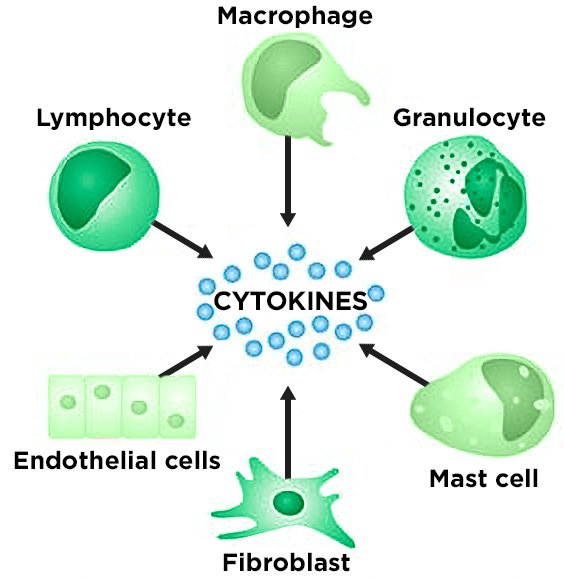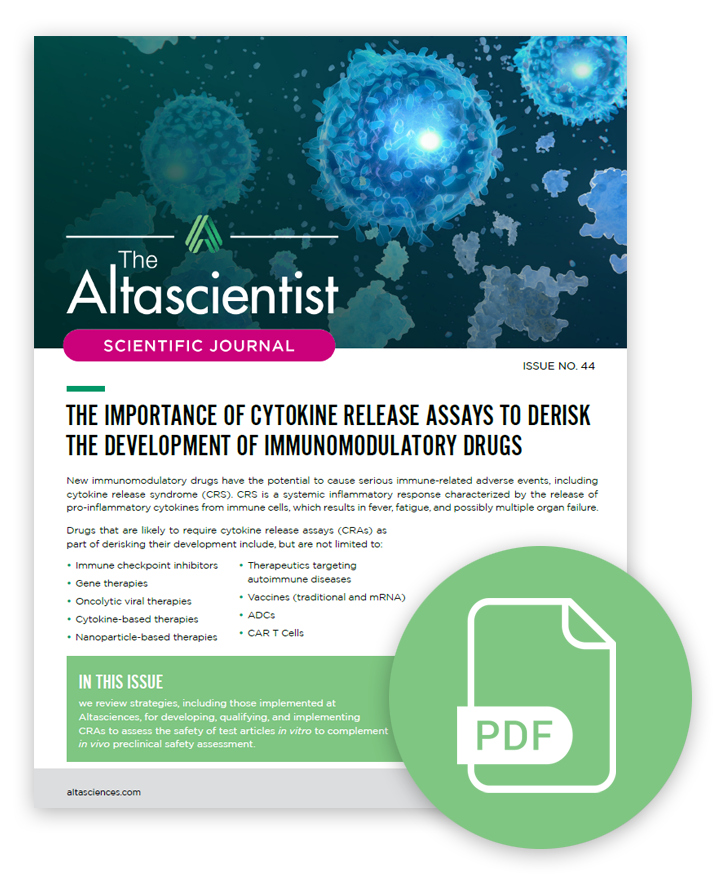ISSUE 44 — The Importance of Cytokine Release Assays to Derisk the Development of Immunomodulatory Drugs
New immunomodulatory drugs have the potential to cause serious immune-related adverse events, including cytokine release syndrome (CRS). CRS is a systemic inflammatory response characterized by the release of
In Issue 44 of The Altascientist, we review strategies, including those implemented at Altasciences, for developing, qualifying, and implementing cytokine release assays (CRAs) to assess the safety of test articles in vitro to complement in vivo preclinical safety assessments, in addition to:
- the importance of nonclinical cytokine release evaluation
- customized approaches to CRA use in drug development
- top five aspects to consider before running a CRA
- Altasciences’ case results
- how Altasciences can help
Drugs that are likely to require CRAs as part of derisking their development include, but are not limited to:
- immune checkpoint inhibitors
- gene therapies
- oncolytic viral therapies
- cytokine-based therapies
- nanoparticle-based therapies
- therapeutics targeting autoimmune diseases
- vaccines (traditional and mRNA)
- antibody-drug conjugates (ADCs)
- chimeric anti gen receptor cells (e.g., CAR T cells)
WHAT IS THE BENEFIT OF NONCLINICAL CYTOKINE RELEASE EVALUATION?
Nonclinical safety assessment serves as a cornerstone in drug development, providing essential data to identify early signs of potential toxicity and inform subsequent clinical trial design. One important aspect of toxicity studies is determining whether the drug produces undesired immune effects. The focus is to ensure that the drug does not have any potential to induce an excessive immune response, particularly cytokine storm, which can lead to severe adverse effects and impede clinical development.

During nonclinical safety assessment, we investigate whether there is an increase or decrease in cytokine production in the serum of dosed animals compared to pre-dose and vehicle controls over time. If there are indications in vivo alluding to a trend, such as a dose-dependent increase of specific cytokines in several or all treated animals, a CRA may be conducted to confirm these results in vitro.
Alternatively, if a drug’s mechanism of action or the patient population being targeted poses a higher risk for undesired immune effects, the CRA may be included in the development pathway prior to starting first-in-human studies, even in the absence of any immunotoxicity trends during nonclinical safety testing.
Customized Approaches to Cytokine Release Assay Use in Drug Development
In a CRA, the test article or antibody therapeutic is co-cultured with human immune cells such as peripheral blood mononuclear cells (PBMCs), whole blood, or other appropriate cells . The amount of inflammatory cytokines produced is measured and provides critical data for hazard identification.
Although there is no published regulatory guidance specific to CRA development, validation, or use, the industry has developed several approaches in performing the CRA assay based on the drug type and its mechanism of action, including:
- PBMC Assays or Whole Blood Assays
- Solid Phase (SP) or Aqueous Phase (AQ) Formats
- Choosing the Right Cytokines to Test
- Appropriate Timepoints for Cytokine Measurement
- Choosing the Appropriate Concentration of Drug Product
- Appropriate Controls for Cytokine Release Assays
Read Issue 44 to learn more about these approaches to performing CRAs.
Explore all issues of The Altascientist in our Resource Center. And don’t forget to subscribe to “The Altascientist: Audiobooks” on Spotify, Apple Podcasts, or wherever you get your audio content.
